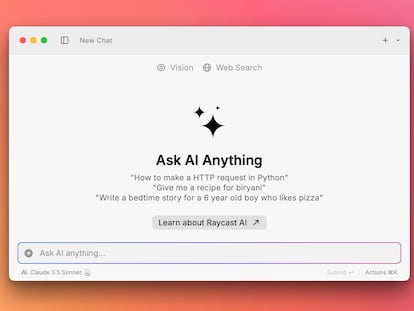Teachers’ mounting ChatGPT frustrations: ‘They keep using it, even though I’ve warned them not to’
After nearly two years of existence, AI text generators are proving to be a growing headache for educators. Though many say there’s no going back to a world without them, the way forward is fraught with obstacles

“It’s exhausting because it keeps happening, there are several students who I warn not to do their work with AI and they just do it again,” says Hernán Ojeda, 33, a high school language and literature teacher in Buenos Aires, Argentina. Two years after their launch, ChatGPT and other AI tools have become widely adopted, including by high school and college students. However, educators are still grappling with how to effectively integrate this technology into the classroom, with many feeling outpaced by the ease with which AI can be used to quickly complete assignments.
“Students don’t even try to hide it. This is just adding to teenagers’ general disaffection with school,” says Ojeda, who posted a viral message on his X account in September about his frustration with the indiscriminate use of AI for assignments. His sentiment has been echoed by other teachers from around the world, who warn about the ease in which students are able to delegate their work to such technological tools.
Dios santo, lo AGOTADOR que es leer tp tras tp feoFEO hecho con chats de IA que dicen un montón de cosas insulsas y absolutamente inespecíficas que a la legua se notan no elaborados por la cabeza de un adolescente prácticamente ágrafo y criado a rutinas de TikTok.
— Rosendo, el dios del verbo amar (@rosendofolner) September 13, 2024
“I’m no longer a teacher. I’m just a human plagiarism detector,” posted Amy Clukey, an associate English professor at the University of Louisville, on X. “Now most of [my] time is just checking to see if a student wrote their own paper. What a waste of life.”
In a Time magazine article titled I Quit Teaching Because of ChatGPT, former professor Victoria Livingstone laments that her efforts at adapting to the new technology have been in vain. In the article, she speaks of students who have developed sophisticated queries and methodology to avoid ever having to write a single paragraph. “Students who outsource their writing to AI lose an opportunity to think more deeply about their research,” Livingstone writes.
Such frustrations aren’t limited to language and literature subjects. Gabriel Rodríguez teaches programming at a professional training school in the Spanish city of Seville. In his introductory course, “I look to shape their minds so that they can think as they should be thinking, with algorithms,” he says. AI is completely prohibited in that first class, but some of his young students use it, nonetheless. In the following course, he teaches information that is more explicitly linked to the professional world, and does integrate AI into classwork.
The professors consulted for this article agreed that “you have to adapt,” but that the road leading towards that adaptation is full of potholes and unforeseen problems. They’re also tired of reading on social media and hearing in real life that they’re no good at their job, or that they need to update their methodologies.
“It’s demoralizing, because since I began to study to be a teacher, my interest has been in pushing traditional education forward,” says Ojeda. “I always look for a way to be more dynamic, entertaining and to avoid the question-and-answer format of previous eras, of memorization.”
That makes the response he gets from some of his students all the more frustrating. “They’re looking to repeat something that already exists. They enter the assignment into ChatGPT and that’s what they turn in,” copying and pasting, sometimes without paying attention to the slightest detail.
Ojeda also has to work around the constant presence of cell phones in the classroom. “They’re often using the AI feature that has been integrated into WhatsApp,” he says. “Given the economic situation [in Argentina] and how expensive books and even photocopying books can be, the large part of our material is digital.” That’s why students always have their phone on hand. Some of them take advantage of this set-up to enter their assignments into WhatsApp, and simply copy and paste the results.
Teacher or cop?
It falls to teachers to address such student laziness as best they can. Before ChatGPT, disaffected young people turned into painfully short assignments. But nowadays, they can generate lengthy essays without giving it more than a cursory glance. “You don’t want to be the police,” says Belén Palop, a professor at the department of education and teacher training center at Madrid’s Universidad Complutense. “Students are telling you that you have to change, that they’ve trolled the system. This is about constantly growing, which is a must for educators.”
Palop sees parallels between the challenges of ChatGPT and the challenges that came with the arrival of the calculator. However, there are nuances to consider: all math teachers agree that students must first master basic operations before relying on calculators. “A calculator is useful for tackling more complex tasks, but students need to learn the fundamentals first,” says Palop.
“Should all children learn to write? Yes. Do they all have to be Nobel prize-winners? No,” she continues. However, the gap between writing and winning a Nobel Prize is much wider than that between knowing one’s times tables and calculating square roots on a calculator.
“Using AI in a didactic way is stupendous because it’s like having your very own teacher at home. But — and this is where teachers get frustrated — students are also putting their assignments into AI, it gives them a response in five minutes, and they don’t give it another thought,” says Rodríguez.
The danger of inertia
“One of the things that really worries me is that AI keeps them from improving their writing,” says Gaby Silva, a literature professor in Guayaquil, Ecuador. “What’s terrible is that you end up becoming the AI police. I’m ashamed to have to be so suspicious all the time. Before, you just had to make sure they weren’t copying and pasting from an existing source.”
As a teacher, one of her great joys was seeing how her students truly improve their skills, says Silva. “It makes me so happy when my students improve their writing, but now that happiness is incomplete, because I don’t know whether they have really gotten better, or if they entered it into AI.”
There’s one important factor that is often glossed over in these situations: student motivation. Rodríguez tells of another teacher who based their classes around the potential of AI. “The students themselves complained about always having to use AI during the class, because they said that they weren’t absorbing the knowledge in the same way,” she says. Sometimes students say they’ll use AI tools — once they get the basics down.
Some educators have found ways to utilize AI wisely. “Not long ago, I went to a presentation by a teacher who made their students describe in detail how Dall-E [an image generator that works with text prompts] came up with the image they had asked for. Suddenly, the ability to write precise descriptions has become important,” Palop says.
But is being able to write a precise query for an AI tool the same as being able to describe a feeling or complex action? Perhaps, but the correlation is far from clear. And professors are now having to deal with students who have taken on — and sometimes, internalized — an overly mature, unnatural way of speaking. “The terminology that is used by AI is often more pompous, it sounds odd coming from young people,” says Ojeda. “There are empty phrases that sound very pretty, it’s like a political speech that takes on sweeping themes, but doesn’t end up saying anything substantial.”
The task of figuring out which students are using AI is complex, but not impossible. According to Rodríguez, it too should fall to machines: “When it comes to programming, detecting it is easy because it’s so obvious. You know each student and how they code. You know when a code is high-quality, when it’s not and which tools have been used to make it. If they’re utilizing commands we haven’t covered yet or the quality is too good, you know they weren’t the ones who wrote it,” he concludes.
Sign up for our weekly newsletter to get more English-language news coverage from EL PAÍS USA Edition
Tu suscripción se está usando en otro dispositivo
¿Quieres añadir otro usuario a tu suscripción?
Si continúas leyendo en este dispositivo, no se podrá leer en el otro.
FlechaTu suscripción se está usando en otro dispositivo y solo puedes acceder a EL PAÍS desde un dispositivo a la vez.
Si quieres compartir tu cuenta, cambia tu suscripción a la modalidad Premium, así podrás añadir otro usuario. Cada uno accederá con su propia cuenta de email, lo que os permitirá personalizar vuestra experiencia en EL PAÍS.
¿Tienes una suscripción de empresa? Accede aquí para contratar más cuentas.
En el caso de no saber quién está usando tu cuenta, te recomendamos cambiar tu contraseña aquí.
Si decides continuar compartiendo tu cuenta, este mensaje se mostrará en tu dispositivo y en el de la otra persona que está usando tu cuenta de forma indefinida, afectando a tu experiencia de lectura. Puedes consultar aquí los términos y condiciones de la suscripción digital.











































